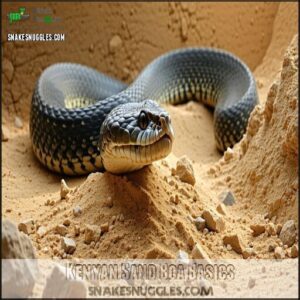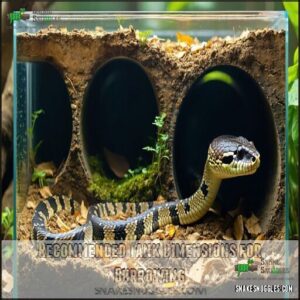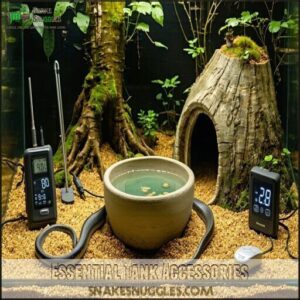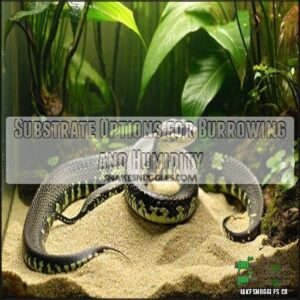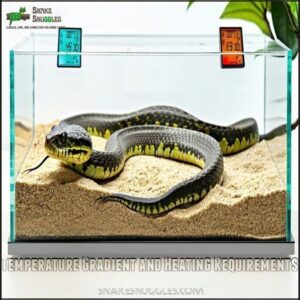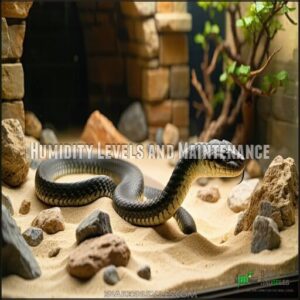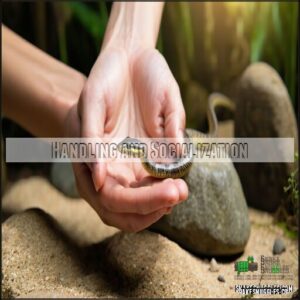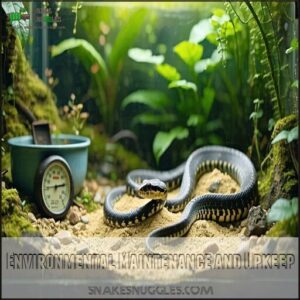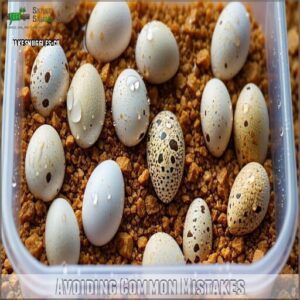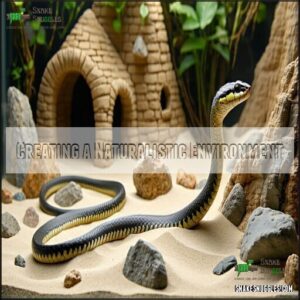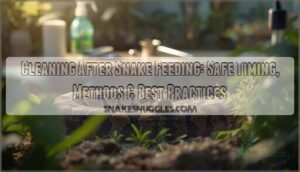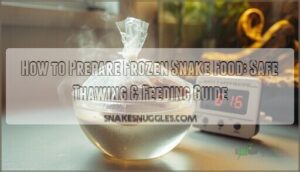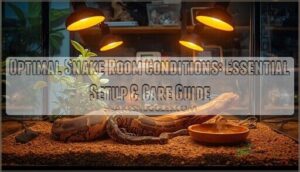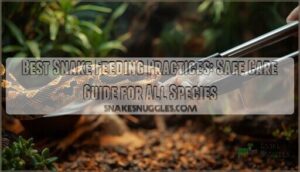This site is supported by our readers. We may earn a commission, at no cost to you, if you purchase through links.

Their calm nature makes them easy to handle, and they’re low-maintenance compared to other snakes. These boas thrive in simple setups with warm temperatures, dry substrate, and a few hides for burrowing—nothing fancy.
Plus, they eat infrequently, usually just a properly sized frozen-thawed mouse every 1-2 weeks. If you’re looking for a snake that’s gentle and hardy, and doesn’t demand constant attention, you’ve found a winner.
Curious about setting up the perfect habitat? There’s more to explore about their care!
Table Of Contents
- Key Takeaways
- Kenyan Sand Boa Basics
- Choosing The Right Tank
- Sand Boa Habitat Design
- Kenyan Sand Boa Diet and Feeding
- Common Health Issues and Prevention
- Handling and Socialization
- Environmental Maintenance and Upkeep
- Avoiding Common Mistakes
- Creating a Naturalistic Environment
- Kenyan Sand Boa Compatibility and Community
- Frequently Asked Questions (FAQs)
- Are Kenyan sand boas easy to care for?
- Is a sand boa a good beginner snake?
- Are Kenyan sand boas good first reptiles?
- Do Kenyan sand boas make regular appearances?
- Can a Kenyan sand boa live together?
- How do I choose a Kenyan sand boa snake?
- Are Kenyan sand boas easy to take care of?
- What is the best beginner boa species?
- How do you tame a Kenyan sand boa?
- How do Kenyan sand boas breed?
- Conclusion
Key Takeaways
- They’re easy to care for with simple setups, like small tanks, dry substrate, and moderate temperatures.
- Their calm nature and manageable size (1-3 feet) make handling stress-free, especially for beginners.
- They’re low-maintenance, needing infrequent feeding (every 1-2 weeks) and minimal attention.
- They’re solitary snakes, so housing them alone prevents stress and health issues.
Kenyan Sand Boa Basics
You’ll find Kenyan Sand Boas (Eryx colubrinus) are small, docile snakes native to northeastern Africa that only grow 1-3 feet long with females typically larger than males.
These stout-bodied burrowers thrive in simple setups with proper temperature gradients (75-95°F) and moderate humidity (30-40%), making them excellent low-maintenance reptiles for first-time snake owners, with proper temperature gradients being key to their care.
Overview of Kenyan Sand Boa Care
Kenyan sand boas offer beginners a straightforward introduction to reptile care, making them ideal first-time snake pets.
These burrowing creatures require minimal maintenance while providing fascinating companionship.
Your sand boa needs:
- An enclosure with proper thermal regulation (90-95°F warm side, 75-80°F cool side)
- Deep substrate for natural burrowing behaviors
- Weekly feeding of appropriately-sized pre-killed mice
- Regular health monitoring for proper shedding and activity
- Gentle handling sessions to build trust
With their manageable size, docile temperament, and simple care requirements, these low maintenance snakes let you enjoy exotic pet ownership without overwhelming responsibility.
Importance of Research Before Buying
Diving into thorough research before buying your Kenyan sand boa prevents future headaches and guarantees proper care. As a beginner snake enthusiast, understanding the specific needs of these beautiful reptiles is essential.
Research areas to prioritize:
- Ethical Sourcing: Verify breeders avoid wild-caught specimens
- Morph Considerations: Different patterns have varying care needs
- Long-Term Commitment: These snakes live 15-20 years
- Financial Implications: Budget for setup, food, and vet care
- Legal Restrictions: Check local laws regarding exotic pet ownership
"Research saved my sand boa from improper temperatures," shares one owner. "They’re perfect beginner reptiles when you’re prepared.
Preparing a Suitable Environment
Setting up your sand boa’s environment requires careful attention to key details.
Your beginner snake will thrive with these essentials:
- Enclosure size of 20 gallons minimum (30" x 12" x 12") for an adult Kenyan sand boa
- Substrate depth of 4-6 inches using aspen shavings or sand/soil mix for natural burrowing
- Temperature gradient with warm side (90-95°F) and cool side (75-80°F) using under-tank heating
- Humidity control at 30-40% with proper ventilation to prevent respiratory issues
Don’t forget to secure the lid—these crafty creatures are escape artists!
Proper enclosure setup guarantees your sand boa stays healthy and content.
Basic Handling Techniques
Before handling your Kenyan Sand Boa, always wash your hands thoroughly.
When lifting your snake, use gentle pressure from underneath, supporting its entire body with a secure grip. Keep handling sessions brief—just 5-10 minutes initially.
These docile creatures rarely bite when handled properly, but watch for stress signs like rapid movement or hiding their head.
For safe snake handling, avoid approaching from above, which mimics predators. With consistent, short sessions and proper snake handling techniques, your sand boa will gradually become comfortable with your touch.
Choosing The Right Tank
You’ll need a 20-gallon tank with at least 4 inches of substrate for your adult Kenyan sand boa to thrive and exhibit natural burrowing behaviors.
The enclosure must have a secure, escape-proof lid since these snakes are skilled escape artists that will exploit any opening they can find, making them expert escape artists.
Minimum Tank Size Requirements
When building a home for your Kenyan sand boa, size matters! Adult snakes require a minimum 20-gallon tank, with females needing larger spaces due to their size.
- Hatchlings start in 10-gallon enclosures for easier monitoring
- Adult dimensions should provide at least 30" x 12" floor space
- Tank material affects heat retention (glass vs. PVC)
- Vertical space isn’t critical as these are ground-dwellers
- Enrichment needs influence tank selection
This beginner snake doesn’t demand massive terrariums, but proper space guarantees they display natural behaviors. Your snake enclosure requirements focus on floor area rather than height, creating an environment where your snake pet can thrive comfortably. Remember: adequate space prevents stress and promotes health.
Recommended Tank Dimensions for Burrowing
Now that you understand the minimum tank requirements, let’s focus on the ideal dimensions for your Kenyan sand boa’s burrowing needs.
Kenyan sand boas are natural burrowers who need the right tank setup to thrive. Your enclosure should emphasize horizontal space rather than vertical space, with minimum dimensions of 30" L x 12" W x 12" H (equivalent to a 20-gallon tank).
These small snakes don’t climb but love to tunnel. Provide at least 5-6 inches of substrate depth using aspen shavings or a sand/soil mixture.
This adequate depth allows your beginner snake to create tunnels and satisfy natural burrowing behavior. Maintaining proper temperature gradients is also critical for their health and well-being.
The enclosure material should be sturdy glass, plastic, or PVC to maintain proper humidity (30-40%). Glass tanks with secure, front-opening doors make observing your easy snake pet simple while still meeting their needs.
Tips for Setting Up a Secure and Escape-Proof Enclosure
Three key elements make a truly escape-proof Kenyan sand boa enclosure.
First, secure your tank with a tight-fitting lid that locks firmly in place—these clever reptiles can push against loose covers with surprising strength.
Don’t underestimate their ability to squeeze through tiny gaps where equipment cords enter the enclosure.
For added security, consider investing in a boa enclosure lock.
Provide proper burrowing depth (5-6 inches of substrate) not just for your snake’s comfort but as an essential escape prevention strategy.
They’re less likely to search for exits when they can satisfy their natural digging instincts.
Place hiding spots away from walls to discourage climbing attempts.
Guarantee adequate ventilation while avoiding creating escape routes through air holes.
Remember the golden rule of snake keeping: if they can fit their head through an opening, their entire body will follow!
Double-check all seals and joints before introducing your new sand boa to its terrarium setup.
Essential Tank Accessories
With your tank secured, essential accessories transform a simple enclosure into a comfortable sand boa habitat.
Every terrarium setup requires these key components:
- Water Bowls – Choose shallow, heavy ceramic dishes that won’t tip over during burrowing activities.
- Hides/Caves – Provide at least two hiding spots—one on the warm side near the heat mat (90-95°F) and another on the cooler side.
- Temperature Tools – Install reliable thermometers at both ends of the enclosure to monitor temperature gradients.
Place away from heat sources to prevent rapid evaporation. Commercial caves or half-log shelters work well. Digital thermometers with probes offer the most accuracy.
Don’t forget feeding tongs for safe meal presentation and a hygrometer to track humidity control. Proper substrate depth (4-6 inches) completes your enclosure setup, allowing natural burrowing behaviors.
Sand Boa Habitat Design
You’ll need to create a habitat that mimics your Kenyan sand boa’s natural desert environment with proper substrate, temperature zones, and hiding spots.
Your sand boa will thrive when you provide 4-6 inches of aspen shavings or sand/soil mix for burrowing along with a temperature gradient of 75-95°F and humidity levels between 30-40%.
This setup will allow your sand boa to burrowing comfortably, ensuring its overall health and well-being.
Substrate Options for Burrowing and Humidity
Creating the ideal ground for your Kenyan sand boa is all about matching its natural burrowing behavior. These snakes love digging, so the right substrate depth and humidity retention are key.
Aspen shavings work well, providing moderate humidity with 4-6 inches of coverage. A sand/soil mix (70/30 ratio) is excellent—it supports burrowing while maintaining 30-40% humidity.
For higher moisture, coconut mulch offers great humidity control but needs careful mold prevention. Avoid substrates with potential toxicity, like cedar or overly damp materials.
Play sand, while cheaper, doesn’t retain humidity effectively. Many keepers source their boa substrate options online.
Choose a substrate that suits your boa’s needs. Verify the enclosure setup promotes natural movement while keeping humidity and health in perfect balance.
Temperature Gradient and Heating Requirements
Proper temperature requirements are key to keeping your Kenyan sand boa happy and healthy. These snakes depend on a stable temperature gradient for thermoregulation.
Set one side of the enclosure to 90-95°F for a basking spot and keep the cool side at 75-80°F. A heat mat works best for this setup.
Place it under the tank to warm the substrate safely, and always connect it to a quality thermostat to avoid overheating. Many owners find specialized heat products essential for their boa.
Here’s how to maintain this gradient effectively:
- Use digital thermometers to monitor warm and cool sides.
- Avoid hot rocks—they can burn your snake.
- Verify nighttime temperatures stay above 70°F.
- Adjust the thermostat regularly to maintain accuracy.
Keep your boa cozy year-round!
Humidity Levels and Maintenance
Kenyan sand boas, like most beginner snakes, thrive in low 30-40% humidity, reflecting their natural desert habitat.
Keep substrate moisture low to avoid scale rot and respiratory problems. Use a hygrometer for precise humidity monitoring and maintain proper ventilation to keep the habitat dry.
- Provide a small water dish on the cool side for minimal humidity and drinking.
- Add a humid hide only during shedding to prevent shedding issues.
- Check ventilation needs regularly to confirm stale air doesn’t cause trapped moisture, helping overall humidity control and snake care.
Creating Hides and Visual Barriers
A naturalistic design with proper hide variety is key to keeping your Kenyan sand boa comfortable and stress-free.
Place hides on both the warm and cool sides of the enclosure for temperature regulation. Cork bark, clay pots, or commercial reptile hides are excellent options.
Add visual enrichment using artificial plants, driftwood, or rocks to mimic their natural environment. Confirm burrowing depth is adequate (4-6 inches of substrate) to encourage natural behaviors.
These features provide enclosure security and promote your snake’s instinct to explore and seek shelter. With thoughtful planning, your pet snake will thrive in a secure and enriched habitat.
Kenyan Sand Boa Diet and Feeding
Feeding your Kenyan sand boa is straightforward and stress-free when you know their dietary needs. These snakes thrive on pre-killed, appropriately sized mice and a consistent feeding schedule.
Understanding Feeding Habits and Prey Preferences
Hungry snakes need the right care, especially in regards to their carnivorous diet.
Your Kenyan sand boa thrives on a consistent snake feeding schedule and properly-sized meals. They aren’t picky eaters, but understanding their snake diet keeps them healthy.
- Prey size: Match the prey to the snake’s widest body part for safe digestion.
- Feeding frequency: Offer food every 5–7 days for juveniles; adults can go longer.
- Thawing methods: Always use warm water (never microwaves) for frozen mice.
- Supplement dusting: Occasionally sprinkle calcium to guarantee balanced nutrition.
- Refusal reasons: Food rejections often occur during shedding or stressful situations.
A peaceful feeding routine encourages your snake to eat without hesitation.
Recommended Prey Items and Portion Sizes
Feeding your Kenyan sand boa is straightforward with a focus on frozen mice.
Always choose prey that matches your snake’s body’s widest point—pinkies for hatchlings and small mice for adults. Over or underfeeding disrupts digestion, so portioning is key.
Here’s a quick guide:
| Snake Age | Prey Type | Frequency |
|---|---|---|
| Hatchling | Pinky Mice | Every 5-7 Days |
| Young Juvenile | Fuzzy Mice | Every 7 Days |
| Adult Male | Small Mouse | Every 10-14 Days |
| Adult Female | Medium Mouse | Every 7-10 Days |
| Breeding Female | Medium Mouse | Weekly (during breeding) |
Stick to this snake diet plan.
Feeding Frequency and Scheduling
Your sand boa’s feeding intervals are key to meeting its dietary needs.
Feed young snakes every 4-5 days, while adult females do well on weekly schedules. Adult males can stretch to 10-14 days.
Follow snake feeding guidelines: choose prey matching their midsection’s width.
Evening meals align with their feeding habits, promoting comfort. If refusal happens, consider stress or environmental factors.
Regularity in the snake feeding process helps prevent obesity, ensuring a thriving and happy pet.
Supplements and Calcium Requirements
Even beginner snakes like Kenyan sand boas benefit from a little extra care in their diet. Calcium requirements are essential for their bone health and overall well-being.
To prevent MBD (metabolic bone disease) and support strong development:
- Dust prey with calcium powder containing vitamin D3 every other feeding.
- Add a multivitamin weekly to maintain balanced nutrients.
- Avoid over-supplementation, which can harm your snake.
Snake care is about balance. A varied diet can also guarantee balanced nutrient intake.
By following this supplement schedule, you’re emphasizing D3 importance while keeping your boa active, healthy, and thriving for years to come.
Common Health Issues and Prevention
Keeping your Kenyan sand boa healthy means understanding common issues like shedding problems or respiratory infections.
With proper care, a clean enclosure, and regular monitoring, you can prevent most health concerns.
Signs of Stress and Illness
Spotting signs of illness in your Kenyan sand boa early can make all the difference. Keep an eye out for these common snake illness symptoms:
| Warning Sign | Possible Cause | Action to Take |
|---|---|---|
| Refusal feeding | Stress or incorrect temps | Check temperature gradient |
| Breathing issues | Snake respiratory illness | Seek immediate veterinary care |
| Wrinkled skin | Dehydration | Increase humidity slightly |
| Lethargy signs | General health decline | Schedule snake veterinary care |
| Skin abnormalities | Mites or scale rot | Inspect and treat promptly |
Regurgitation causes could include stress or improper feeding. Look for mites as tiny black dots, while scale rot shows as belly discoloration.
Regular health checks help prevent snake health issues. If your boa shows labored breathing or mucus buildup, it may have a respiratory illness requiring urgent care.
Preventing Infections and Metabolic Bone Disease
Keeping your Kenyan sand boa healthy starts with proactive care. Hygiene practices are key—clean the enclosure weekly and keep humidity under 50% to avoid respiratory issues.
Quarantine procedures for new snakes help prevent infections from spreading. For metabolic bone disease prevention, focus on calcium supplementation and proper temperature gradients.
Here’s how to support snake health:
- Offer calcium powder every other feeding.
- Balance calcium and phosphorus in the diet.
- Maintain warm and cool zones in the enclosure.
- Provide fresh water daily.
- Monitor for symptoms like lethargy or poor appetite.
By following these steps, you can ensure your Kenyan sand boa remains healthy, and prevent infections from spreading, which is crucial for their well-being.
Maintaining Proper Hygiene and Sanitation
Cleanliness is the cornerstone of snake care, keeping your Kenyan sand boa healthy and stress-free.
Regular maintenance minimizes risks of infections and illnesses.
Here’s how to maintain high-quality hygiene:
- Waste Removal: Scoop out feces and uneaten prey daily to prevent bacteria buildup.
- Substrate Cleaning: Fully replace bedding every 3-4 months or sooner if soiled.
- Disinfecting Enclosures: Deep clean the snake enclosure monthly using reptile-safe disinfectants.
By following these snake care tips, you’ll create a safe, comfortable habitat while ensuring effective snake illness prevention.
Importance of Regular Veterinary Check-Ups
Regular vet check-ups are a must for your Kenyan sand boa’s health.
A qualified snake veterinarian can spot issues early, like respiratory infections, parasites, or shedding problems, making treatment easier and more effective.
Preventative care guarantees proactive health by addressing concerns before they escalate, and parasite prevention, for instance, protects your snake’s long-term wellness.
These visits also help evaluate husbandry practices, like humidity or temperature settings, to keep your boa thriving, and snake veterinary care options include routine exams, medications, and husbandry evaluation, all essential for snake illness prevention.
A little prevention goes a long way!
Handling and Socialization
Handling your Kenyan sand boa is simple if you approach it with care and patience.
These snakes are naturally docile, making them easy to manage and great for building trust over time.
Getting Your Kenyan Sand Boa Used to Handling
When bringing home your Kenyan sand boa, patience is key to building trust.
These beginner-friendly snakes need time to adjust before handling. Start with an initial acclimation period of at least one week, allowing them to settle into their new environment.
Once they seem comfortable, begin with short, gentle interactions.
- Gradual introduction: Handle for 5 minutes every other day, increasing time as they relax.
- Recognizing comfort: Watch for signs like calm movements; avoid handling if they vibrate their tail or burrow away.
- Handling frequency: Keep sessions consistent but brief to build trust without overwhelming them.
By respecting their boundaries, you’ll develop a rewarding bond with this easy reptile.
Gentle Handling Techniques and Support
A Kenyan sand boa’s docile nature makes it a perfect snake for beginners, but safe lifting is essential.
Always support its entire body to avoid stress. Use handling tips like cradling it in your palm or creating a gentle “finger bridge” for middle support.
Avoid one-handed holds, as they can make the snake feel insecure. Gradual introduction to handling builds confidence and strengthens trust.
Keep sessions short at first, ensuring the snake feels secure. By reading signals and providing full support, you’ll create a positive experience for this burrowing beauty.
Recognizing Stress Signals and Backing Off
When handling your Kenyan sand boa, pay close attention to its body language to spot stress signs.
Rapid tail vibrations, jerky movements, or hissing mean it’s time for a safe retreat. A musking defense—releasing a foul odor—signals extreme discomfort. Tight coiling with its head tucked shows fear, while repeated escape attempts indicate handling limits have been reached.
- Rapid tail movements: A clear sign your boa feels threatened.
- Musking: A strong reaction to overwhelming stress.
- Tight coiling: Your docile snake is scared and seeking protection.
Respect these signals to build trust with this beginner-friendly pet.
Socialization and Building Trust
Building trust with your Kenyan sand boa takes consistent interaction and gentle handling.
Start with short, 5-minute sessions twice a week, gradually increasing time as your docile snake becomes more comfortable. Always support its entire body and use confident, calm movements.
Positive reinforcement, like returning it to its enclosure when showing stress signals, helps reduce stress over time. Recognizing signals such as rapid movements or defensive postures is key.
With patience, this best beginner snake will become a relaxed, rewarding pet.
Environmental Maintenance and Upkeep
Keeping your Kenyan sand boa’s environment clean and well-maintained is essential for its health and comfort.
Regular tasks like replacing substrate, monitoring temperature, and ensuring proper humidity levels will keep your snake thriving.
Cleaning and Disinfecting The Tank
Keeping the snake enclosure clean is key to your boa’s health.
Regular snake habitat maintenance reduces bacteria and odors.
- Daily waste removal: Clear droppings, shed skin, and leftovers.
- Weekly wipe-down: Use reptile-safe disinfectant on surfaces and refresh water bowls.
- Monthly deep clean: Replace substrate, sanitize snake enclosure accessories, and inspect for mold.
Stay consistent with these preventative measures!
Substrate Replacement and Humidity Control
Maintaining the right substrate and humidity control in your snake enclosure keeps your Kenyan sand boa healthy and happy. Replace the substrate every 3-4 months to avoid mold and guarantee a clean snake habitat.
For ideal humidity (30-40%), follow these steps:
- Spot clean daily to remove waste while preserving burrowing areas.
- Keep substrate types like aspen or sand/soil mix at 4-5 inches deep for moisture balance.
- Mist one corner lightly if humidity drops below 30%.
Proper humidity monitoring prevents shedding issues and discomfort, which is crucial for the well-being of your Kenyan sand boa, ensuring it remains happy.
Monitoring Temperature and Lighting
After setting up the substrate, it’s time to focus on temperature and lighting.
Kenyan sand boas thrive with a proper temperature gradient—keep the warm side at 90-95°F and the cool side around 75-80°F.
Use a heat mat paired with a thermostat for precise calibration and consistent warmth.
Nighttime heat should stay above 70°F to guarantee comfort.
While UVB lighting isn’t required, it supports natural behaviors and adds to their well-being.
A 12-hour light cycle with timers helps mimic their natural environment effectively.
Pruning and Replacing Live Plants
Live plants can elevate your Kenyan Sand Boa’s habitat, adding beauty and functionality to the setup.
But they need proper care to confirm they’re safe and beneficial for your snake.
- Plant Toxicity: Choose non-toxic species to avoid harm if your boa comes into contact with them.
- Pruning Techniques: Trim overgrown leaves with clean scissors to maintain a tidy, manageable space.
- Root Health: Check roots regularly to verify they’re thriving in the substrate.
- Soil Composition: Use snake-safe soil that supports plant growth without compromising burrowing needs.
- Plant Selection: Opt for hardy plants that can tolerate low light and dry conditions.
A well-maintained plant setup enhances snake habitat design, promoting sustainability and enriching your pet’s environment.
Avoiding Common Mistakes
Making mistakes is easy when you’re new to keeping Kenyan sand boas, but most are preventable with proper knowledge.
Understanding their needs for space, heat, and handling helps guarantee your pet stays healthy and stress-free.
Inadequate Tank Size and Space
A cramped snake enclosure stunts your Kenyan sand boa’s Growth and Space needs, leading to stress and health problems.
These snakes thrive in tanks measuring at least 36x18x18 inches, with 4-6 inches of substrate for proper Burrowing Depth.
Without this, their natural behaviors are restricted, causing Enrichment Limitations and potential Stress Indicators like lethargy or refusal to eat.
Investing in a spacious snake tank setup isn’t just about comfort—it reduces Long-Term Costs by preventing stress-related illnesses. Prioritize proper snake habitat design to support their burrowing instincts and overall well-being.
Insufficient Heat, Humidity, and Lighting
Your Kenyan sand boa’s comfort depends on proper heat, humidity, and lighting.
Aim for a basking spot at 95°F and a cool side around 75°F to create a healthy thermal gradient. Keep humidity at 30–40% using light mists or humidity hides.
Use a reliable lighting schedule to mimic natural day-night cycles. Regular temperature monitoring is key to avoiding stress or illness.
- Tip: Place heating mats under the tank, not inside, to prevent substrate overheating.
Poor Handling Techniques and Over-Handling
Handling your Kenyan sand boa the right way is essential for keeping it happy and stress-free. These pet snakes thrive on gentle, supportive interactions.
- Always support their entire body to prevent them from feeling insecure or stressed.
- Avoid tail grabbing or squeezing snakes, as this can cause discomfort or fear.
- Limit handling frequency to a few times a week, with sessions lasting 10-15 minutes.
Watch for stress signs like rapid tail movements, burrowing attempts, or refusal to engage. It’s also important to avoid handling them during periods of shedding to minimize stress.
Practicing proper snake handling techniques guarantees safety, builds trust, and highlights their docile nature.
Neglecting Veterinary Care and Monitoring
Skipping vet checkups can lead to big problems for your sand boa.
Even hardy snakes face risks like parasites, infections, or shedding complications that aren’t always obvious. Without preventative care, these issues might escalate into costly emergencies.
Regular visits to a reptile veterinarian facilitate illness detection early, giving your snake the best chance at staying healthy.
Watch for signs like appetite loss, weight changes, or unusual behavior—these could signal the need for snake veterinary treatment.
Quarantine protocols are also vital when introducing new reptiles to avoid spreading parasites or diseases.
Snake veterinary services aren’t just for emergencies; they’re about long-term care. A little attention now saves stress later. Remember, consistent snake veterinary care options keep your boa thriving and you worry-free, ensuring your snake receives the best chance at a healthy life.
Creating a Naturalistic Environment
You can create a naturalistic environment for your Kenyan sand boa by mimicking its desert habitat with sand, rocks, and sturdy hides.
This setup both keeps your snake comfortable and encourages its natural burrowing and exploratory behaviors.
Incorporating Rocks, Logs, and Plants
Building the perfect snake habitat enriches your Kenyan sand boa’s life and keeps them happy. Focus on safety and function.
- Safe Rock Types: Use flat, stable rocks for basking. Anchor them securely to prevent tipping and injuries.
- Log Placement Benefits: Hollow logs mimic burrows, offering cozy hiding spots and natural exploration spaces.
- Plant Toxicity Risks: Stick to reptile-safe artificial plants. They add aesthetic design without worrying about harmful toxins.
- Burrowing Support: Provide a sand-soil mix substrate for easy digging, mimicking their desert home.
These elements create a safe, enriching environment for your pet snake to thrive.
Providing Visual Barriers and Hides
Feeling secure is essential for your Kenyan sand boa’s happiness. Adding visual barriers and safe hides mimics their natural habitat and encourages burrowing behavior.
- Snug hide boxes: Provide cozy, beginner-friendly hiding spots.
- Decorative rocks or tunnels: Great for enclosure enrichment and naturalistic design.
- Artificial or live plants: Offer cover while reducing stress.
These features keep your docile snake calm and also enhance the enclosure’s look, making care simple and enjoyable for new owners.
Simulating Natural Light and Shadows
Lighting plays a key role in your Kenyan sand boa’s well-being.
Mimic its natural diurnal cycle with a simple light spectrum setup.
While these snakes don’t need strong UVB, low-intensity UV lighting supports vitamin D production and immunity.
Use a timer to maintain a consistent 12-hour cycle: dim UVB at dawn and dusk encourages activity and exploration, while brighter LED light during the day simulates resting phases.
At night, turn off all lights to create natural shadow placement and cooling.
This beginner-friendly approach guarantees your snake thrives in a habitat setup that mirrors its natural seasonal variation.
Adding Decorations and Texture
Adding decorations and texture makes your Kenyan sand boa’s enclosure feel like home.
Use textured backgrounds and vary the burrowing depth with mini dunes for digging.
Place rocks thoughtfully for basking and hiding, ensuring rock placement is stable to prevent accidents.
Add climbing branches or smooth logs for enrichment.
Choose plant safety by using artificial plants or hardy succulents.
These elements create a beginner-friendly setup that mimics natural habitats, keeping your boa engaged while showcasing its manageable size and simple care needs.
Kenyan Sand Boa Compatibility and Community
You’ll find Kenyan sand boas prefer solitary living, so housing them together isn’t recommended.
Instead, focus on creating a thriving reptile community by connecting with other enthusiasts to share tips and experiences.
Housing Multiple Sand Boas Together
Kenyan sand boas are happiest alone, but cohabitation can work if you’re cautious.
These snakes are solitary by nature, and housing them together risks stress, aggression, or even injury.
If you decide to try, follow these guidelines:
- Space Requirements: Provide at least 2 extra square feet per snake.
- Gender Combinations: Avoid housing males together to prevent fights.
- Feeding Strategies: Always feed snakes separately to avoid competition.
Behavioral monitoring is vital to guarantee harmony.
Multiple hides in the snake enclosure reduce stress and mimic natural snake habitat requirements, but solitary living remains the safest option for these introverted reptiles.
Understanding Social Structure and Hierarchy
Kenyan sand boas have a solitary nature, thriving best on their own without interspecies interaction.
These snakes don’t form bonds and prefer personal space, making them beginner-friendly for those new to reptiles.
Their social structure is simple but worth understanding:
- Burrowing habits: Each snake claims its own space under the substrate, avoiding others.
- Dominance displays: Males may show subtle behaviors during breeding, like scent marking or competing for mates.
- Limited communication: Interactions are rare, mainly defensive or tied to breeding behavior.
Their docile nature and preference for solitude mean they’re happiest when housed alone, ensuring stress-free handling and care.
Their care is also simplified by their need for a specific temperature gradient.
Creating a Community of Reptile Enthusiasts
Building connections with reptile enthusiasts can make caring for your kenyan sand boa much easier.
Local Reptile Clubs are great for meeting like-minded people and learning hands-on care techniques. Join online forums to exchange tips with experienced keepers or troubleshoot issues like feeding refusals.
Attending reptile shows introduces you to breeders who prioritize breeding ethics and can guide you in selecting a healthy, beginner-friendly snake.
Many groups also promote conservation efforts, helping you learn about responsible pet ownership.
These communities are invaluable for advice on handling your docile boa or managing health concerns. Finding your tribe guarantees you’re never alone in your journey with this rewarding reptile pet.
Frequently Asked Questions (FAQs)
Are Kenyan sand boas easy to care for?
Caring for Kenyan sand boas is straightforward.
They thrive in simple setups, need minimal space, and have easy feeding schedules.
Their docile nature and low-maintenance requirements make them an excellent choice for reptile enthusiasts.
Is a sand boa a good beginner snake?
Sand boas are great beginner snakes.
They’re small, hardy, and low-maintenance.
Their docile nature makes handling easy, and their simple care needs—like moderate temperatures and occasional feeding—make them ideal for first-time reptile owners, with a particularly docile nature.
Are Kenyan sand boas good first reptiles?
These snakes are fantastic for first-time reptile owners.
Their manageable size, calm temperament, and low-maintenance care make them ideal.
Just verify proper enclosure setup, feeding, and handling to keep them healthy and stress-free.
Do Kenyan sand boas make regular appearances?
You might think Kenyan sand boas are rare, but they’re actually quite popular in the reptile community.
Their unique burrowing behavior, manageable size, and vibrant morphs make them a fascinating choice for enthusiasts and breeders alike.
Can a Kenyan sand boa live together?
Kenyan sand boas shouldn’t live together.
They’re solitary snakes and can become stressed or aggressive if housed with others.
Sharing space might also lead to feeding issues or injuries, so always provide separate enclosures for each.
How do I choose a Kenyan sand boa snake?
Choose a Kenyan sand boa by checking its health—clear eyes, smooth skin, and steady movement.
Avoid snakes with visible injuries or lethargy.
Prioritize reputable breeders or pet stores for proper care history and accurate morph details.
Are Kenyan sand boas easy to take care of?
With females growing up to three feet, Kenyan sand boas are manageable pets.
They thrive in small tanks, need simple care, and show docile temperaments, making them ideal for beginners seeking a low-maintenance snake.
What is the best beginner boa species?
The best beginner boa species is the rosy boa.
It’s small, docile, and easy to care for.
With simple habitat needs and a calm temperament, it’s perfect for someone new to keeping snakes.
How do you tame a Kenyan sand boa?
Start by letting it adjust to its enclosure for a few days.
Handle gently from the middle, avoiding sudden movements.
Keep sessions short at first, increasing gradually. Consistency builds trust, making taming easier over time.
How do Kenyan sand boas breed?
Breeding Kenyan sand boas involves creating a brumation period by lowering temperatures to 60-70°F for 6-8 weeks.
Pair males and females afterward, ensuring proper conditions.
Mating occurs quickly, and females give live birth months later.
Conclusion
It’s almost impossible to find a snake better suited for beginners than the Kenyan sand boa.
Their manageable size, gentle temperament, and low-maintenance care make them an ideal choice for first-time snake owners.
With the right setup—warm temperatures, dry substrate, and secure hides—they thrive in captivity.
Plus, their infrequent feeding schedule is perfect for busy lifestyles.
If you’re wondering, “Are Kenyan sand boas good for beginners?” the answer is a resounding yes. They’re simple, hardy, and rewarding pets.
- https://brevardzoo.org/animals/paws-on-play/wildlife-detective-training-academy/kenyan-sand-boa/
- https://search.proquest.com/openview/f618d00ea7587d85c4bd09b69a2a0d75/1?pq-origsite=gscholar&cbl=18750&diss=y
- https://vetmed.illinois.edu/pet-health-columns/pet-snakes-diet-dead-alive/
- http://digimorph.geo.utexas.edu/specimens/Eryx_colubrinus/
- https://www.sciencedirect.com/science/article/pii/S1319562X14000382

